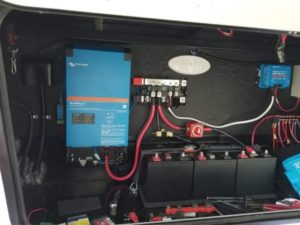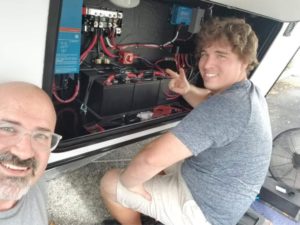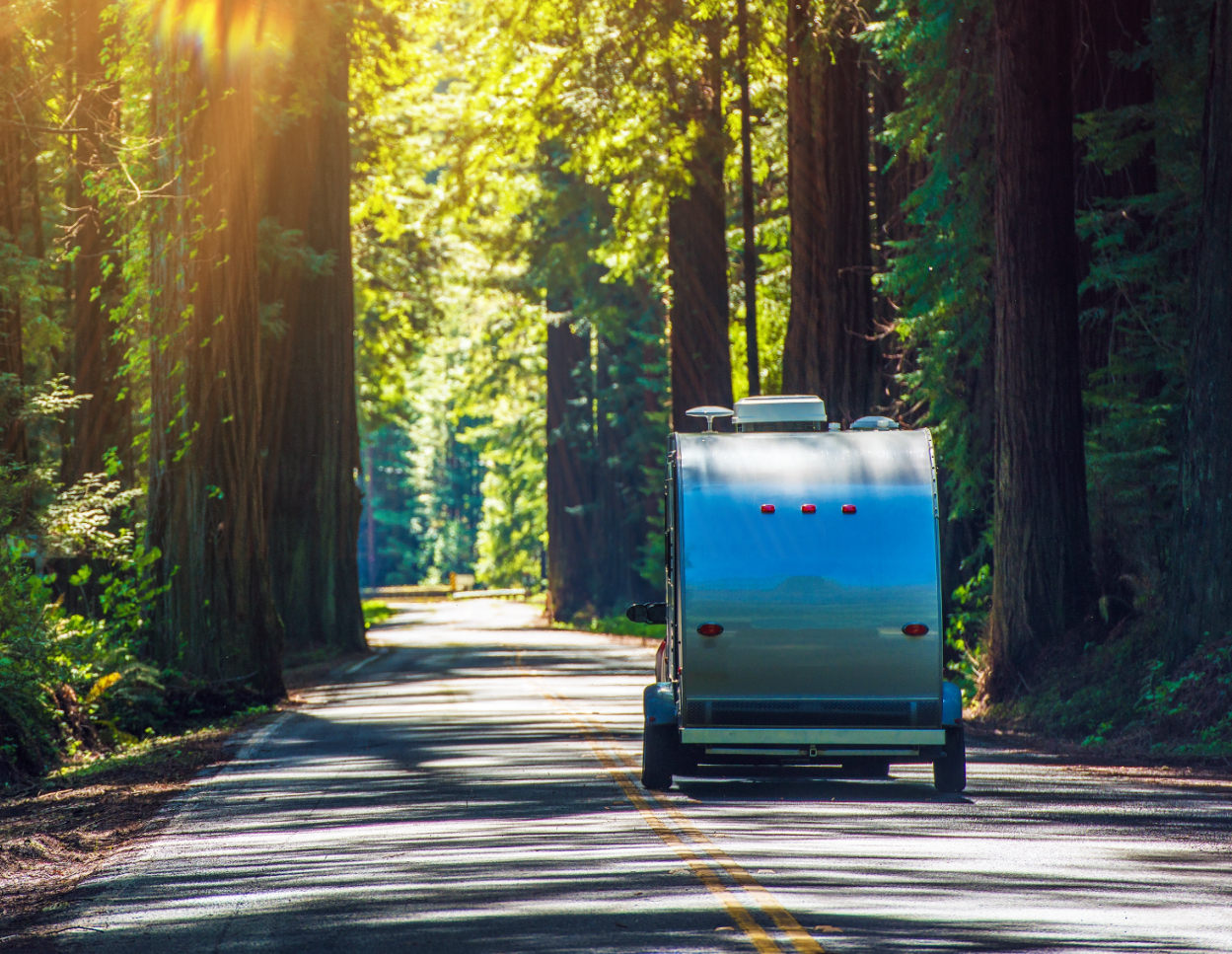 For most RV campers, “boondocking” is a mythical form of camping. Disconnected, off the grid, separated from other campers – just you and your crew deep in the state or national park or out-of-the-way getaway where no power, water or sewer lines can reach. Just like the pioneers used to do. But glampers aren’t pioneering woodsfolk, unless the pioneers had their own memory foam bed, and shower, and fridge, and solid roof and door to keep out the elements and creatures. Modern boondockers want the creature comforts only power can deliver.
For most RV campers, “boondocking” is a mythical form of camping. Disconnected, off the grid, separated from other campers – just you and your crew deep in the state or national park or out-of-the-way getaway where no power, water or sewer lines can reach. Just like the pioneers used to do. But glampers aren’t pioneering woodsfolk, unless the pioneers had their own memory foam bed, and shower, and fridge, and solid roof and door to keep out the elements and creatures. Modern boondockers want the creature comforts only power can deliver.
Enter solar power.
 Barry’s long thought about solar for his travel trailers. With two kids now out of the house and in college and “Bertha,” his new Grand Design Reflections 150 Series fifth-wheel at the ready, it seemed the right time to amp up his camping.
Barry’s long thought about solar for his travel trailers. With two kids now out of the house and in college and “Bertha,” his new Grand Design Reflections 150 Series fifth-wheel at the ready, it seemed the right time to amp up his camping.
The right solar array would mean he could (theoretically) leave the 50 amp power cord behind and camp anywhere his 2500 could pull the trailer.
Barry didn’t come into this knowing everything he needed to know to pull off a solar install. Cost was a major consideration, but costs have been steadily dropping for any components. He did know he wanted a modest system, something that would run most components in the trailer, and maybe the AC a couple hours during the heat of the day.
 After all, he wouldn’t be camping in the Florida heat in the dead of summer. A small to medium sized solar set up wouldn’t require sacrificing a lot of storage space in the fifth-wheel to make space for the batteries and components. Running the AC for the entire day requires a large system, so that wasn’t considered.
After all, he wouldn’t be camping in the Florida heat in the dead of summer. A small to medium sized solar set up wouldn’t require sacrificing a lot of storage space in the fifth-wheel to make space for the batteries and components. Running the AC for the entire day requires a large system, so that wasn’t considered.
He’d done his research – YouTube is his favorite source of RV education. He knew what would go into the install. But making holes all over the rig, especially the roof, is a little unnerving. Even to someone who has been RVing for six years and has some basic skills with power tools, Barry didn’t want to make this journey solo.
So Barry hired a RV solar expert to make some suggestions and handle the install. Jeff from Expert Mobile Solar spent a few hours via Zoom call sharing his insights, and learning what Barry wanted out of his system. The goal was to be able to comfortably overnight on the road to a destination, or perhaps weekend at a festival without full hookups. Boondocking for a few nights in a remote location would be bonus.
After the consult, Jeff sent Barry a shopping list of products he’d need, and a couple options on purchasing. Once Amazon and UPS delivered the goods, Jeff travelled to South Florida and the two spent a weekend performing the install. A long hot weekend in the South Florida sun.
 Working with that list, Barry unboxed two 200-watt solar panels, three 100ah lithium batteries, an inverter/charger, and various other components, cables, shunts, dongles and Wifi, USB and HDMI adapters and the 50 feet of RJ45 cable needed to connect and complete his system.
Working with that list, Barry unboxed two 200-watt solar panels, three 100ah lithium batteries, an inverter/charger, and various other components, cables, shunts, dongles and Wifi, USB and HDMI adapters and the 50 feet of RJ45 cable needed to connect and complete his system.
He also bought the Victron Multiplus II that combines the 3000-watt inverter/converter/transfer switches, making installation a little cleaner.
For many of the products, Jeff recommended Continuous Resources, one of a few highly rated solar vendors that provide excellent tech support to their customers. The online vendor offers great customer service and can help buyers not only with warranty for Victron components, but with any technical issues that might arise with the install and beyond. Reputable dealers and resellers are essential, especially for products like Victron, which is manufactured in the Netherlands.
“Unfortunately, numerous people have had issues with exchanges or warranty when ordered from Amazon and Ebay,” Jeff says, “so I would not recommend buyers go that route.”
 We know what Barry bought. What didn’t he buy? He opted out of the adapter to charge the batteries off the tow vehicle while driving. He didn’t want to run any more cables. Besides, the solar panels should keep the batteries topped off en route, unless it’s raining. The system also is optimized to work well with his compact 2000kw Honda generator.
We know what Barry bought. What didn’t he buy? He opted out of the adapter to charge the batteries off the tow vehicle while driving. He didn’t want to run any more cables. Besides, the solar panels should keep the batteries topped off en route, unless it’s raining. The system also is optimized to work well with his compact 2000kw Honda generator.
“That’s always good for back-up or supplementing the system,” he says.
Barry also splurged on the SoftStartRV device that reduces start-up power demand by up to 70% and gently smooths out the startup of the RV air conditioner compressor.
Finally, the system has a hard-wired, 50 amp EMS Whole RV Surge Protector to protect the expensive solar system from crappy power at camp-sites. Barry no longer needs an external surge protector in line from the power post. His EMS does surge, as well as EMS / line conditioning, which surge protectors that most campers buy for around $100 don’t do.
The Hughes EMS unit Bluetooths to the phone with detailed info power and line data. In fact, most of his new solar system Bluetooths to his Samsung phone. Some Bluetooth options allow system control and visual monitoring from one screen when nearby or in the RV. His system’s networked touch screen maximizes all the networking Victron offers. Users can turn the inverter on and off and check battery status via Bluetooth with the free Victron App via a phone, tablet, or computer. The solar charge controller also has Bluetooth built in to monitor the battery, the inverter and the solar charge controller (MPPT).
“It will show the solar production, inverter controls, battery percentage and everything in one spot,” Jeff says.
Barry’s 5er Bertha already had the Lippert app to control the lights, awning, slide out, and leveling jacks. “Nowadays everything seems to be coming with built-in Bluetooth,” he says.
What did all this set Barry back? The materials and installation were north of $6,000. Sure, you can go cheaper, and DIYers will scoff at paying retail or hiring anyone to handle something they’ll boast on social media they also can do in a weekend.
Barry’s content with his investment. First, Jeff warned against buying from off-price, online retailers; you could void the warranty or make servicing a component a PITA. A small system, similar to what some RV manufacturers are offering as a factory option, typically runs about $2,500 installed. A medium-sized system like the one Barry installed commonly runs $5,000 t0 $7,000; larger systems capable of easily running AC all day would easily cost $8,000 to $12,000.
Prices are dropping. Lithium batteries have slowly been coming down in cost over the past few years. The most common size used in RVs (100ah) were $1000 each a few years ago, and are now approaching the $500 mark.
Besides, if you want to do some serious remote camping – just like the pioneers did – you have to take your solar system seriously. Check back once Barry does some boondocking this fall…
[ end ]
